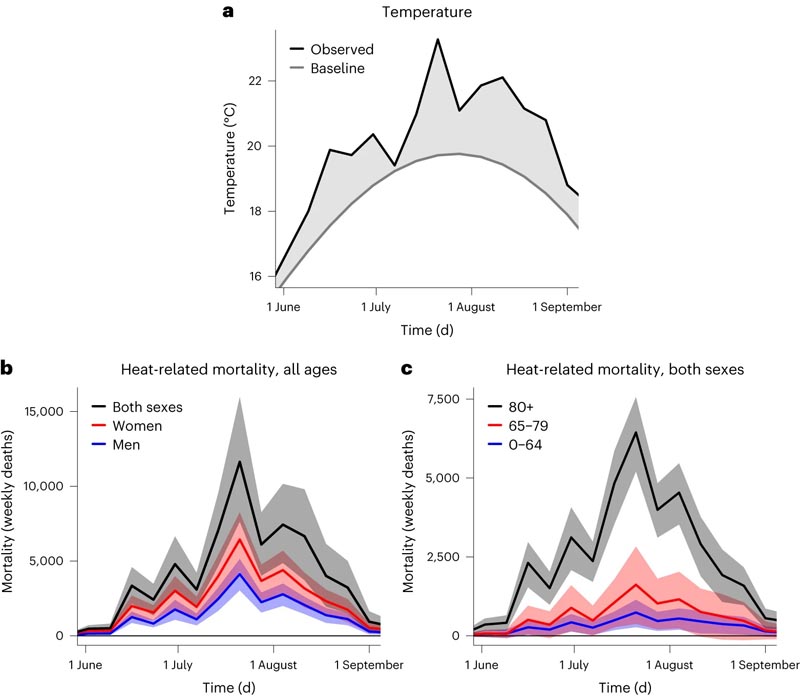Anthropogenic greenhouse gas emissions have caused a detectable increase in global temperatures, which is associated with an increase in the frequency and intensity of heat waves and hot summers. Globally, the last 8 years have been the warmest on record, and 2022 was the fifth warmest year. In this context, Europe emerges as an important climate hotspot , given that warming from pre-industrial levels is almost 1 °C higher than the corresponding global increase, and higher than that of any other continent. Furthermore, climate change projections for the continent indicate that temperatures and their health impacts will increase at an accelerated rate unless robust mitigation and adaptation measures are implemented.
Heat exposure poses a major threat to high-risk populations in Europe and around the world, contributing substantially to increased morbidity and mortality . Heat waves are the most impactful extreme weather events in terms of attributable death counts. Heat-related mortality has been a major concern over the past two decades in Europe, especially after the excess of 71,449 deaths recorded during the months of June, July, August and September 2003.
The resulting social awareness of the short-term health effects of heat led to the design and implementation of heat prevention plans and other adaptation strategies to protect at-risk populations across the continent, i.e. older adults with medical conditions. pre-existing cardiovascular and respiratory diseases, women and socially isolated or socioeconomically disadvantaged people. While there is some evidence that heat prevention plans, including preparedness and response strategies, intervention actions, and heat health early warning systems, can reduce the health burden of ambient temperatures, the Evidence of its effectiveness is still limited.
The summer of 2022 was the hottest season on record in Europe, characterized by an intense series of heat waves, leading to extremes in terms of temperature, drought and fire activity. The European Statistical Office, Eurostat, reported unusually high excess mortality rates for summer 2022, but the burden of heat-related mortality across the European continent has not been quantified so far. The objective of this study was to use epidemiological models to estimate the sex- and age-specific mortality burden associated with the record temperatures recorded during the 14-week period between May 30 and September 4, 2022 (weeks 22 to 35). . Furthermore, we compare this mortality burden within the broader context of the summer of 2003 and the accelerated warming observed on the continent over the past decade (2013-2022).
Summary
More than 70,000 excess deaths occurred in Europe during the summer of 2003. The resulting social awareness led to the design and implementation of adaptation strategies to protect at-risk populations. Our objective was to quantify the burden of heat-related mortality during the summer of 2022, the hottest season on record in Europe. We analyzed the Eurostat mortality database, which includes 45,184,044 death counts from 823 contiguous regions in 35 European countries, representing the total population of more than 543 million people.
We estimate 61,672 (95% confidence interval (CI) = 37,643–86,807) heat-related deaths in Europe between May 30 and September 4, 2022. Italy (18,010 deaths; 95% CI = 13,793–22,225), Spain (11,324; 95% CI = 7.908–14,880) and Germany (8.173; 95% CI = 5.374–11,018) had the highest numbers of summer heat-related mortality, while Italy (295 deaths per million, 95% CI = 226–364), Greece (280, 95% CI = 201–355), Spain (237, 95% CI = 166–312), and Portugal (211, 95% CI = 162 –255) had the highest rates of heat-related mortality.
Relative to the population, we estimate 56% more heat-related deaths in women than men, with higher rates in men ages 0-64 (+41%) and ages 65-79 (+14%). and in women over 80 years old (+27%).

Figure : a, Weekly initial (gray line) and observed (black line) temperature (°C) averaged over Europe. Temperature anomalies are defined as the difference between observed and reference temperatures (gray shading). Reference temperatures were calculated as the average annual cycle of temperatures observed in the reference period 1991-2020. b, c, Weekly heat-related mortality (weekly deaths) aggregated in Europe for the general population (black), women (red) and men (blue) (b) and people aged 0 to 64 years (blue), 65 to 79 (red) and 80+ (black) years (c), along with their 95% CIs (shaded). Numbers of women and men in b do not include the UK; Values for the age groups in c do not include Germany, Ireland and the United Kingdom.
Conclusions
Due to global warming, temperatures in Europe are rising at a faster rate than the global average. Considering the magnitude of heat-related mortality on the continent, our results call for a reassessment and strengthening of heat monitoring platforms, prevention plans, and long-term adaptation strategies.
The high heat-related mortality that Europe experienced during the summer of 2022 demands that national governments and relevant agencies at the European Union and continental levels urgently increase the ambition and effectiveness of heat prevention and adaptation plans.















